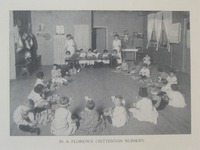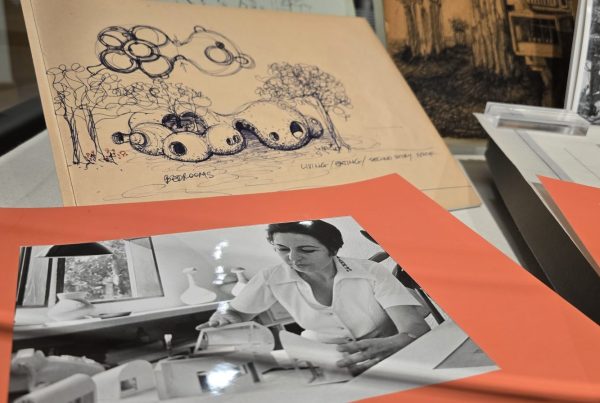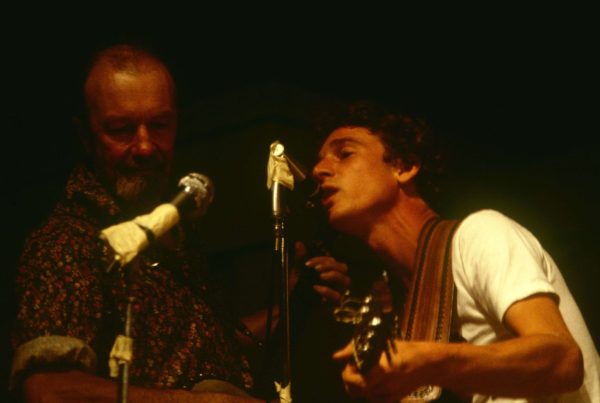by Linnea Anderson, Archivist, Social Welfare History Archives
Archives and Special Collections staff work with numerous graduate and undergraduate classes during a semester. One of the classes that regularly use the archives is Organizational Approaches to Youth Development taught by Professor Jennifer Skuza from the Center for Youth Development. Lindsey Cacich Samples, a student in this class wrote a blog entry reflecting on her experience using a collection in the Social Welare history Archives. Lindsey and her class partner, Genta Hayes, did an historical research project using records of the National Florence Crittenton Mission maternity homes for single mothers. Inspired by the documents, they wrote a script and delivered a dramatic interpretation about the Crittenton Homes for their class project.
 A little over a year ago, I was in a class that culminated in a final project involving research in the Andersen archives. On an October evening, our class was given an orientation by Andersen staff as we perused some sample boxes of archives from youth serving organizations of the past. Unfamiliar and overwhelmed by the number of choices, my partner and I finally stumbled upon an organization that struck a chord with us. The Florence Crittenton Mission was a home for unwed mothers, providing them a safe place to stay, where they wouldn’t be scorned by their community, and where they learned job and life skills to support their young family. After honing in on a topic, we asked to view a number of boxes from the archives. A full day at the library skimming over the contents of the boxes and we were able to narrow down our search- we were interested in the early years of the budding organization with a goal to find as much evidence to the client’s experience in the homes as possible. There was a lot of information that discussed what services the homes provided the women, but it was more of a stretch to find the voices of the women they served in their archives.
A little over a year ago, I was in a class that culminated in a final project involving research in the Andersen archives. On an October evening, our class was given an orientation by Andersen staff as we perused some sample boxes of archives from youth serving organizations of the past. Unfamiliar and overwhelmed by the number of choices, my partner and I finally stumbled upon an organization that struck a chord with us. The Florence Crittenton Mission was a home for unwed mothers, providing them a safe place to stay, where they wouldn’t be scorned by their community, and where they learned job and life skills to support their young family. After honing in on a topic, we asked to view a number of boxes from the archives. A full day at the library skimming over the contents of the boxes and we were able to narrow down our search- we were interested in the early years of the budding organization with a goal to find as much evidence to the client’s experience in the homes as possible. There was a lot of information that discussed what services the homes provided the women, but it was more of a stretch to find the voices of the women they served in their archives.
Our focus on the women’s experience led to the unveiling of stories upon stories. That is what history is, isn’t it? It’s one giant story. Our journey through the Andersen archives was like trying to piece together the puzzle of this organization’s story. We kept finding clues and threads of information here and there as we tried to figure out how it all fit together. When it came time to present our research to our class, we decided to become storytellers, actors performing the characters, scenes, dialogues, and poetry we found in the archives. Instead of talking about our findings we lived our research in front of the class to give our classmates of flavor of our experience conducting this research. We gave monologues by the founders and leaders of the organization. We performed poetry written by and about the young women they served. We held a board meeting, asking classmates to read minutes from meetings held across the country. We gossiped about the “loose women” who had children out of wedlock. We inducted the class into training school for the House Matrons who headed up each of the homes. It was exciting and motivating to view our research as a performance and bring history to life for our class. When we embodied the information we discovered, we couldn’t help but get to the heart of the mission and vision of this work.
– Lindsey Cacich Samples, M.Ed. in Youth Development Leadership in Fall 2013.




